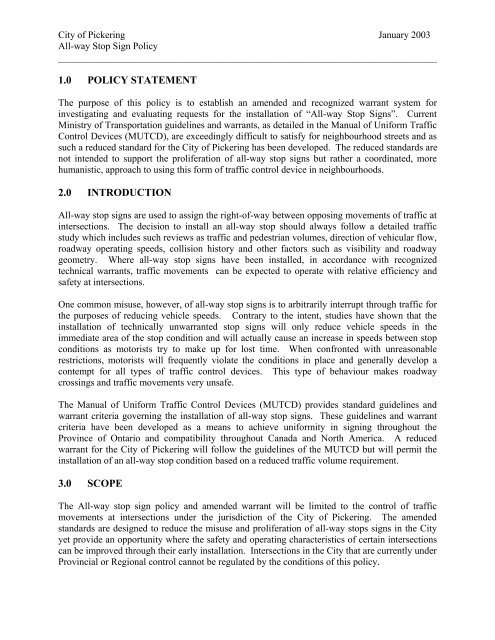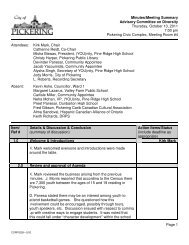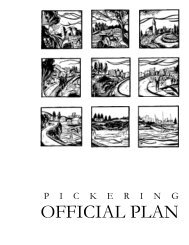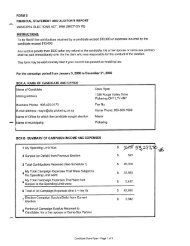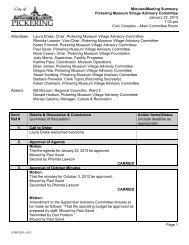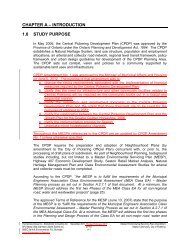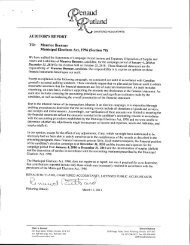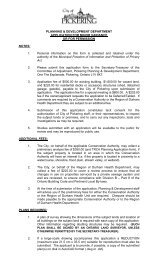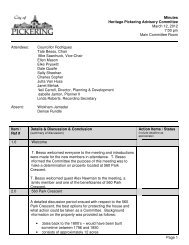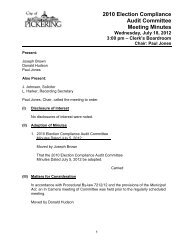foreword - City of Pickering
foreword - City of Pickering
foreword - City of Pickering
Create successful ePaper yourself
Turn your PDF publications into a flip-book with our unique Google optimized e-Paper software.
<strong>City</strong> <strong>of</strong> <strong>Pickering</strong> January 2003<br />
All-way Stop Sign Policy<br />
______________________________________________________________________________<br />
1.0 POLICY STATEMENT<br />
The purpose <strong>of</strong> this policy is to establish an amended and recognized warrant system for<br />
investigating and evaluating requests for the installation <strong>of</strong> “All-way Stop Signs”. Current<br />
Ministry <strong>of</strong> Transportation guidelines and warrants, as detailed in the Manual <strong>of</strong> Uniform Traffic<br />
Control Devices (MUTCD), are exceedingly difficult to satisfy for neighbourhood streets and as<br />
such a reduced standard for the <strong>City</strong> <strong>of</strong> <strong>Pickering</strong> has been developed. The reduced standards are<br />
not intended to support the proliferation <strong>of</strong> all-way stop signs but rather a coordinated, more<br />
humanistic, approach to using this form <strong>of</strong> traffic control device in neighbourhoods.<br />
2.0 INTRODUCTION<br />
All-way stop signs are used to assign the right-<strong>of</strong>-way between opposing movements <strong>of</strong> traffic at<br />
intersections. The decision to install an all-way stop should always follow a detailed traffic<br />
study which includes such reviews as traffic and pedestrian volumes, direction <strong>of</strong> vehicular flow,<br />
roadway operating speeds, collision history and other factors such as visibility and roadway<br />
geometry. Where all-way stop signs have been installed, in accordance with recognized<br />
technical warrants, traffic movements can be expected to operate with relative efficiency and<br />
safety at intersections.<br />
One common misuse, however, <strong>of</strong> all-way stop signs is to arbitrarily interrupt through traffic for<br />
the purposes <strong>of</strong> reducing vehicle speeds. Contrary to the intent, studies have shown that the<br />
installation <strong>of</strong> technically unwarranted stop signs will only reduce vehicle speeds in the<br />
immediate area <strong>of</strong> the stop condition and will actually cause an increase in speeds between stop<br />
conditions as motorists try to make up for lost time. When confronted with unreasonable<br />
restrictions, motorists will frequently violate the conditions in place and generally develop a<br />
contempt for all types <strong>of</strong> traffic control devices. This type <strong>of</strong> behaviour makes roadway<br />
crossings and traffic movements very unsafe.<br />
The Manual <strong>of</strong> Uniform Traffic Control Devices (MUTCD) provides standard guidelines and<br />
warrant criteria governing the installation <strong>of</strong> all-way stop signs. These guidelines and warrant<br />
criteria have been developed as a means to achieve uniformity in signing throughout the<br />
Province <strong>of</strong> Ontario and compatibility throughout Canada and North America. A reduced<br />
warrant for the <strong>City</strong> <strong>of</strong> <strong>Pickering</strong> will follow the guidelines <strong>of</strong> the MUTCD but will permit the<br />
installation <strong>of</strong> an all-way stop condition based on a reduced traffic volume requirement.<br />
3.0 SCOPE<br />
The All-way stop sign policy and amended warrant will be limited to the control <strong>of</strong> traffic<br />
movements at intersections under the jurisdiction <strong>of</strong> the <strong>City</strong> <strong>of</strong> <strong>Pickering</strong>. The amended<br />
standards are designed to reduce the misuse and proliferation <strong>of</strong> all-way stops signs in the <strong>City</strong><br />
yet provide an opportunity where the safety and operating characteristics <strong>of</strong> certain intersections<br />
can be improved through their early installation. Intersections in the <strong>City</strong> that are currently under<br />
Provincial or Regional control cannot be regulated by the conditions <strong>of</strong> this policy.


